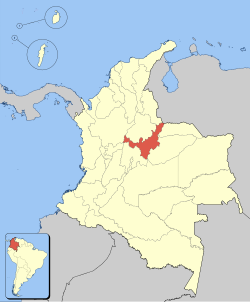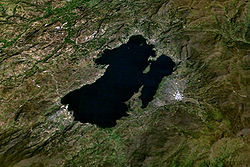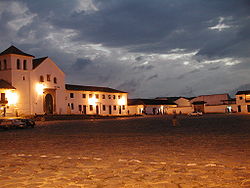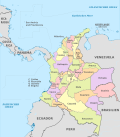Boyacá Department: Difference between revisions
m Replacing Colombia-boyaca-SIM.svg with File:Colombia_Boyaca_loc_map.svg (by Trijnstel because: File renamed: File rename criterion #6). |
m r2.7.2) (Robot: Modifying diq:Boyaca (Eyalet) to diq:Boyacá |
||
| Line 347: | Line 347: | ||
[[war:Boyacá (departamento)]] |
[[war:Boyacá (departamento)]] |
||
[[yo:Boyacá Department]] |
[[yo:Boyacá Department]] |
||
[[diq: |
[[diq:Boyacá]] |
||
[[zh:博亚卡省]] |
[[zh:博亚卡省]] |
||
Revision as of 20:36, 24 November 2012
Department of Boyacá
Departamento de Boyacá | |
|---|---|
|
| |
| Motto(s): Boyacá, Duty of Everyone (Spanish: Boyacá, Deber de todos) | |
 Boyacá shown in Colombia | |
| Country | |
| Region | Andean Region |
| Established | 1858 |
| Capital | Tunja |
| Government | |
| • Governor | José Roso Millán (Green Party of Colombia Option Center) |
| Area | |
• Total | 23,189 km2 (8,953 sq mi) |
| • Rank | 20 |
| Population (2005)[1] | |
• Total | 1,211,186 |
| • Rank | 13 |
| • Density | 52/km2 (140/sq mi) |
| Time zone | UTC-05 |
| ISO 3166 code | CO-BOY |
| Municipalities | 123 |
| Website | www.boyaca.gov.co |
Boyacá (Spanish pronunciation: [boʝaˈka]) is one of the 32 Departments of Colombia, and the remnant of one of the original nine states of the "United States of Colombia".
Boyacá is centrally located within Colombia, almost entirely within the mountains of the Eastern Cordillera to the border with Venezuela, although the western end of the department extends to the Magdalena River at the town of Puerto Boyacá. Boyacá borders to the north with the Department of Santander, to the northeast with the Bolivarian Republic of Venezuela and the Norte de Santander Department, to the east with the Departments of Arauca and Casanare. to the South, Boyacá borders with the Department of Cundinamarca and to the west with the Department of Antioquia covering a total area of 23,102 km² (8,880 sq mi). The capital of Boyacá is the city of Tunja.
Boyacá is known as "The Land of Freedom" because this region was the scene of a series of battles which led to Colombia's independence from Spain. The first one took place on July 25, 1819 in the Pantano de Vargas and the final and decisive battle known as the Battle of Boyacá was fought on August 7, 1819 at Puente de Boyacá.
Boyacá is home to three universities: the Universidad Pedagógica y Tecnológica de Colombia (UPTC), the Universidad de Boyacá (UNIBOYACA), and the Universidad Santo Tomás.
Origin of the name
The word Boyacá' derived from the chibchan word "Bojaca" which means "near the Cacique" or "Region of the Royal Mantle"
History

The territory of present day Boyaca was during the Pre-Columbian time a domain of the Muiscas indigenous peoples. The Muiscas under the chiefdom of El Zaque of Hunza lived mainly by agriculture and mining.
The first European to discover the area was the Spaniard Gonzalo Jiménez de Quesada who conquered and distributed the land in encomiendas and forced the indigenous people to work for him.
In 1539, Gonzalo Suárez Rendón, a Spanish colonist, founded the village of Tunja and other sites where the indigenous people previously had their villages. The village of Tunja became one of the main political and economic centers for the Spanish during the Viceroyalty of New Granada.
During the 19th Century Boyaca was battleground for numerous confrontations between the royalist and patriot armies led by Simón Bolívar during the Spanish colonies' war of independence from Spain. Two of the most decisive battles were the Battle of Boyacá and the Vargas Swamp Battle (1819) won by the patriot forces against the royalists. In 1824 Gran Colombia created the Boyacá Department (Gran Colombia).
After the creation of the Granadine Confederation by 1858 the territory of now Boyaca became the Sovereign State of Boyacá. It was later rearranged in territory and administration and renamed as "Department of Boyaca" after a series of civil wars like the Colombian Civil War (1860-1862) and the Thousand Days War that struggled over a centralist or federalist system and political instability that changed to many constitutions (such as the Constitution of 1886), Boyaca finally acquired its current definition as territory.
Geography


Boyacá is located in the Andean Region in central Colombia, over the Cordillera Oriental mountain range and covers a total area of 23.189 km². Borders to the north with the departments of Santander and Norte de Santander, with which it holds a territorial dispute, to the east with the departments of Arauca and Casanare, to the south with the departments of Meta and Cundinamarca and to the west with the departments of Cundinamarca holding another territorial dispute and Antioquia.
The department of Boyaca covers a small portion of the Middle Magdalena valley of the Magdalena River to the west, the Cordillera Oriental mountain range with altitudes of 5,380 m above sea level (Sierra Nevada del Cocuy with 25 snow peaks), flat highland plateaux and another small portion of territory by the eastern Llanos plains. Among its most prominent geographical features are the Range of the Zorro, Serrania de las Quinchas and the Andean plateaus of Rusia, Guantiva, Pisba, Chontales and Rechiniga.
The tableland of Boyaca shared with the department of Cundinamarca is called the Cundiboyasense tableland (Template:Lang-es), densely populated with numerous valleys in comparison with the Bogota Savanna which also lays over the Cundiboyasense tableland.
Many rivers spring from this area--the most important being the Chicamocha River and Arauca River and tributaries to other important rivers such as the Magdalena and Meta.
Boyacá also has numerous lakes which include Lake Tota, Lake Sochagota, Lake Fúquene which is shared with the department of Cundinamarca, the Chivor Reservoir and others.
Most of these areas are covered by El Cocuy and Pisba National Parks, the latter being shared with the department of Arauca. It also has the flora and fauna sanctuary Iguaque Sanctuary.
Climate
The central area of the tableland has two rainy seasons; the first between April and June, and a second between October and November with an average of 1,000 km³ of rainfall per year. The rest of the year is considered to be the dry seasons with intermittent rainfall. The area over the Cordillera Central mountain range with an average of 2,500 km³ a year.
Provinces and Municipalities




There are 13 provinces and two special districts in the Boyacá Department, listed below with their 123 municipalities. The department also has 123 corregimientos, 185 police inspectorates and numerous towns and small villages spread throughout the territory.
Municipalities are also grouped into 45 notary circuits with 53 notaries public. One circuit main registry based in the capital of the department; Tunja and 13 other minor registries spread across the territory.
|
Special Handling Zone |



